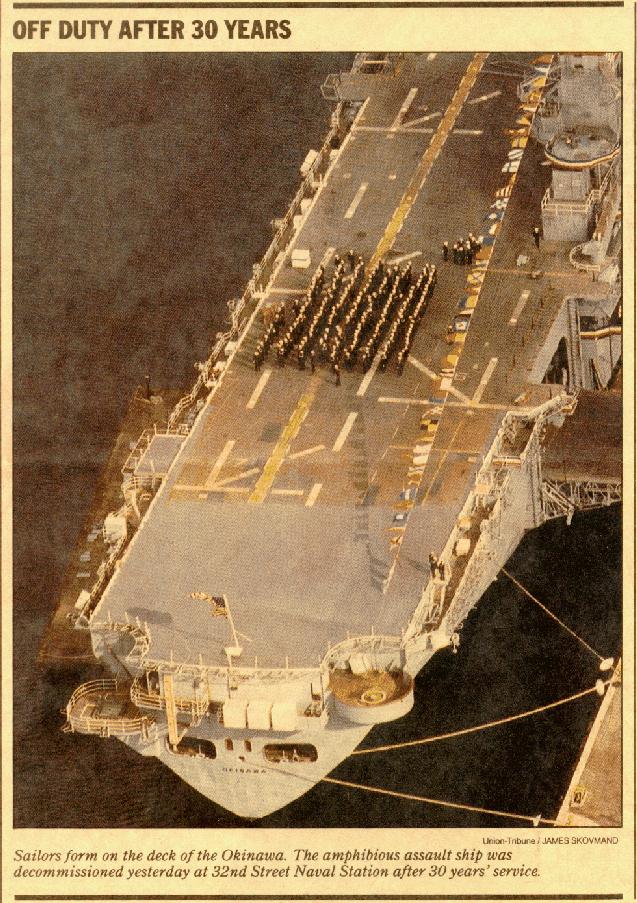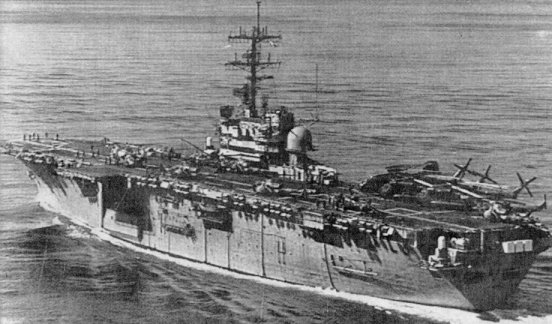 |
 |
| San Diego Union-Tribune Dec 1992 By Jim O'Connell Staff Writer
 Designed to deliver up to 2000 Marines and 20 helicopters to the center of danger, the Okinawa was once the proud flagship of a five-vessel amphibious group. Designed to deliver up to 2000 Marines and 20 helicopters to the center of danger, the Okinawa was once the proud flagship of a five-vessel amphibious group. But her 30 years of service ends today. She is being retired due to age, budget considerations and force reductions, and will be towed to Northern California and sold for scrap. But her 30 years of service ends today. She is being retired due to age, budget considerations and force reductions, and will be towed to Northern California and sold for scrap."We can still her engines, and we can silence her bells, but we can never erase the history that has been made by this great ship and the |  REUTERS Memories: Amphibious assault ship Okinawa served in two wars  | ||
men who sailed in her," said Vice Admiral W.J. Flanagan. The decommissioning ceremony at 2 p.m. today at the 32nd Stree Naval Station, will be filled with pride for the crew, and memories tinged with humor, former officers said. The decommissioning ceremony at 2 p.m. today at the 32nd Stree Naval Station, will be filled with pride for the crew, and memories tinged with humor, former officers said. Built in the Philadelphia Naval Shipyard during a period of tight budgets, the Okinawa lacked amenities - like a second propeller - and occasionally suffered for it, said retired Capt. William Mackey, a former executive officer on the ship. Built in the Philadelphia Naval Shipyard during a period of tight budgets, the Okinawa lacked amenities - like a second propeller - and occasionally suffered for it, said retired Capt. William Mackey, a former executive officer on the ship. "Some of the men used to call her the 'Brokinawa,' " Mackey said. "And she drove like a bathtub, not responsive at all. But she gave honorable service. She was a good ship with a good crew." "Some of the men used to call her the 'Brokinawa,' " Mackey said. "And she drove like a bathtub, not responsive at all. But she gave honorable service. She was a good ship with a good crew."  A crew of 684 manned the ship, which was based in San Diego in 1967. A crew of 684 manned the ship, which was based in San Diego in 1967. |
 Retired Capt. Roger Newman, a former commanding officer of the Okinawa, said that on his first day in command, the ship broke down just out of port and drifted listlessly until it could be repaired. Retired Capt. Roger Newman, a former commanding officer of the Okinawa, said that on his first day in command, the ship broke down just out of port and drifted listlessly until it could be repaired. "That day seemed to take forever," he recalled. "That day seemed to take forever," he recalled. But bonds, as strong as the links on the Okinawa's 1,100-foot anchor chain, slowly formed between the ship and it's crew. But bonds, as strong as the links on the Okinawa's 1,100-foot anchor chain, slowly formed between the ship and it's crew. "You put so much of yourself into your tour, and make such good friends, that the vehicle becomes a symbol of that experience," Newman said. "You put so much of yourself into your tour, and make such good friends, that the vehicle becomes a symbol of that experience," Newman said."I can't explain it, but the ship is a part of you and you are a part of it.  And when they haul down the colors, and the thing goes dead - goes silent - it kind of gets to you. And when they haul down the colors, and the thing goes dead - goes silent - it kind of gets to you. "Built at a cost of $40 million, the Okinawa is nearly two football fields long, and "Built at a cost of $40 million, the Okinawa is nearly two football fields long, and |
featured a 200 bed hospital and eight helicopter landing spots all protected by four 50-calber guns and Sea Sparrow missiles. During her prime, the Okinawa was a fierce warrior that led six amphibious assaults during the Vietnam War. She also helped evacuate Phnom Penh and Saigon, and rescued shot-down pilots from the sea. One of the pilots rescued by the Okinawa was Randy "Duke" Cunningham, R-San Diego, who is now a two term congressman. During her prime, the Okinawa was a fierce warrior that led six amphibious assaults during the Vietnam War. She also helped evacuate Phnom Penh and Saigon, and rescued shot-down pilots from the sea. One of the pilots rescued by the Okinawa was Randy "Duke" Cunningham, R-San Diego, who is now a two term congressman. In 1968, the Okinawa picked the unmanned Apollo 6 space capsule from the sea, and in August 1971, was chosen to recover the crew and capsule of Apollo 15. In 1968, the Okinawa picked the unmanned Apollo 6 space capsule from the sea, and in August 1971, was chosen to recover the crew and capsule of Apollo 15. The first amphibious flagship in the Arabian Gulf in support of Operation Desert Shield, the Okinawa was back in the gulf when the Persian Gulf War began in January 1991. The first amphibious flagship in the Arabian Gulf in support of Operation Desert Shield, the Okinawa was back in the gulf when the Persian Gulf War began in January 1991. | |
 |  |  |  |